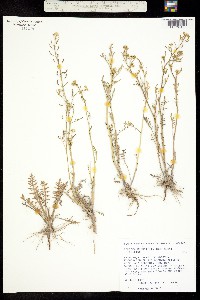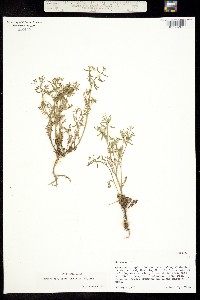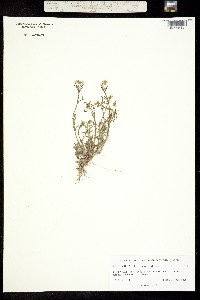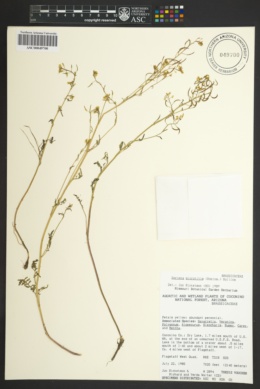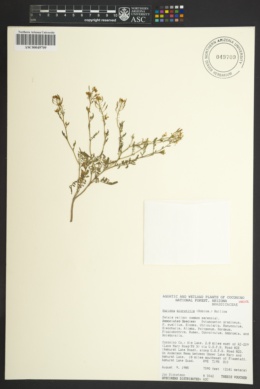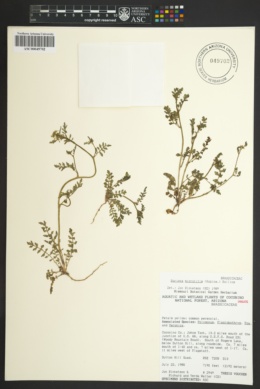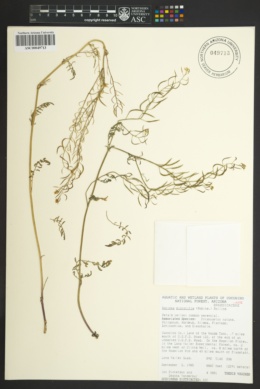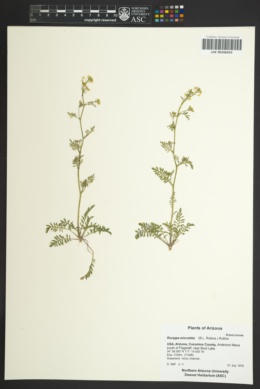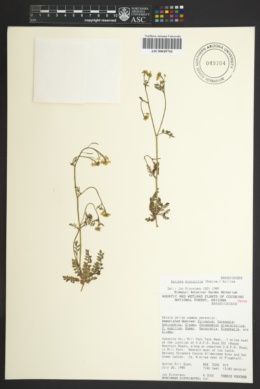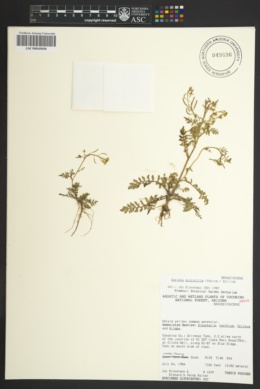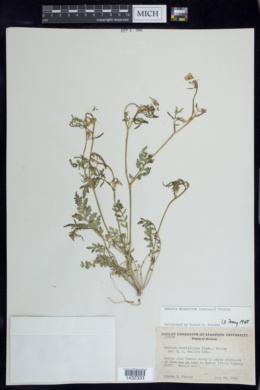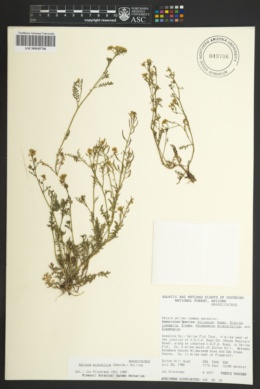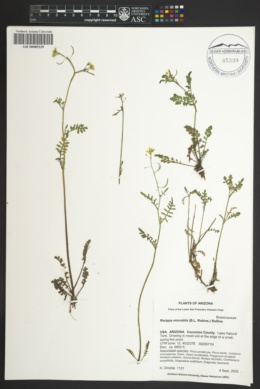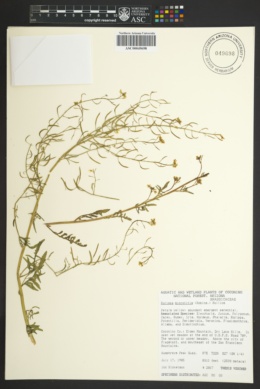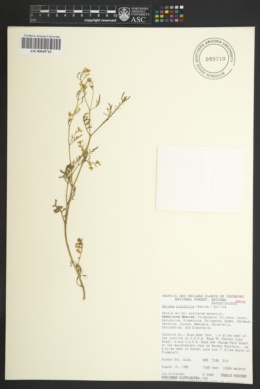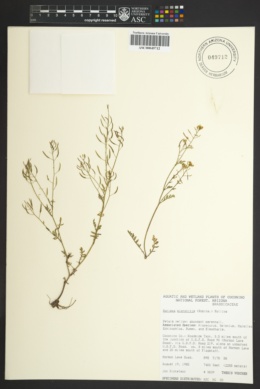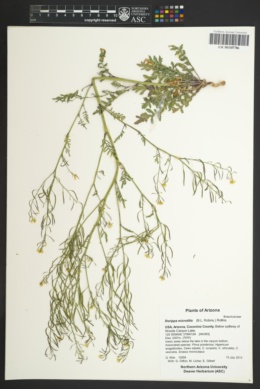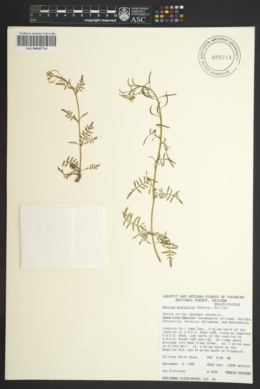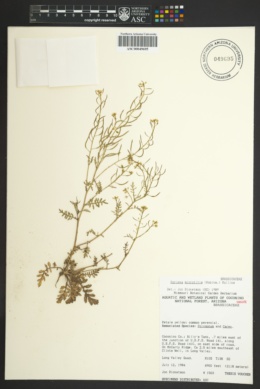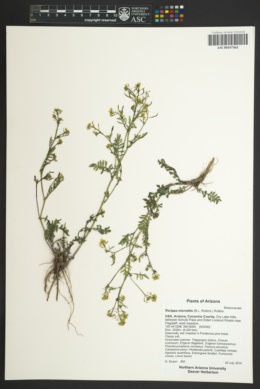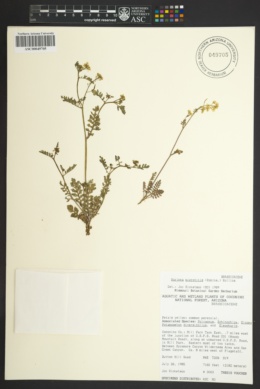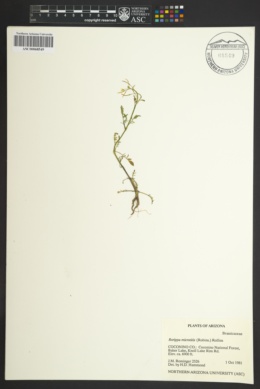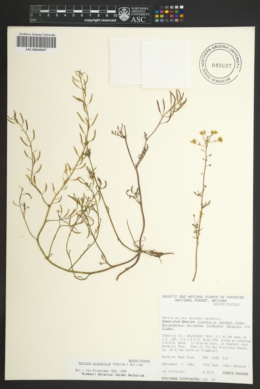Rorippa microtitis
|
|
|
|
Family: Brassicaceae
Chihuahuan Yellowcress
[Sisymbrium microtites B.L. Robins.] |
Annuals or, rarely, biennials; usually glabrous throughout, rarely sparsely pubescent proxi-mally. Stems (simple or few from base), erect, branched distally, 1.5-6 dm. Basal leaves often not rosulate; blade margins pinnatifid. Cauline leaves petiolate; blade pinnatifid to pinnatisect or pectinate, (lobes 4-10 on each side, linear or oblong to ovate), 4-13 cm × 9-35 mm; base auriculate, margins entire or dentate, or (distally) pinnately lobed. Racemes (subumbellate), considerably elongated. Fruiting pedicels divaricate-ascending to horizontal, straight, 3-11 mm. Flowers: sepals ascending to spreading, oblong, 2-3 × 0.7-1 mm; petals (spreading), yellow, spatulate, 2.5-4 × 0.7-1.2 mm; median filaments 1.8-3 mm; anthers oblong, 0.5-0.8 mm. Fruits siliques, usually curved inward, rarely straight, linear, (8-)10-17(-20) × 1-2 mm; ovules 42-68 per ovary; style 0.5-1(-1.2) mm. Seeds biseriate, reddish brown, cordiform, 0.6-0.9 mm (0.5-0.6 mm diam.), reticulate-foveolate. Flowering Jun-Aug. Wet pastures, moist fields, ponds, ditches, meadows; 1700-2300 m; Ariz., N.Mex.; Mexico (Chihuahua). General: Annual to short-lived perennial, 30-60 cm tall; stems solitary to few, erect; herbage glabrous; taprooted. Leaves: Basal and cauline, alternate, oblanceolate, 5-12 cm long, 1-3 cm wide, pinnately divided to pectinate (comb-like), margins of the lobes often dentate, the terminal lobe narrow, the apex rounded; blades petiolate, not clasping. Flowers: Inflorescence a raceme, dense in flower, elongating in fruit; pedicels S-curved, horizontally spreading to infrequently slightly recurved; sepals lance-elliptic, 4.3-6.5 mm long; petals oblanceolate, spatulate, or obovate, 6.5-10 mm long, weakly differentiated into blade and claw, yellow; flowers May-June. Fruits: Silique, elongate cylindrical, 1-1.5 cm long, straight to slightly curved inward; seeds 20-80 per silique. Ecology: Moist fields, meadows, creeks, ditches, wet soils; 1800- 2400 m (6000-8000 ft); Apache, Coconino, Graham, Navajo, and Pinal counties; southwestern U.S., Mexico. Notes: Rorippa curvipes (blunt-leaf yellowcress) is somewhat similar to R. microtitis, but has a prostrate, decumbent, ascending to sometimes erect habit; herbage is moderately hirsute at the base on the stems and upper leaf surfaces, sometimes glabrous; basal leaves (withering early) are entire or pinnately divided, cauline leaves are oblanceolate to ovate, 3-12 cm long, reduced upwards, crenate-dentate or more commonly pinnatifid, margins of the lobes entire, crenate, or sinuate-crenate; fruiting pedicels are widely divergent to recurved, 1.5-4 mm long; sepals and petals are smaller (sepals 1-1.5 mm long, petals 0.5-1.2 mm long); fruit is a silique (or sometimes a silicle), short-cylindrical, 2.5-8 mm long. It typically occurs in ditches, streams, pond and lake margins, and moist and muddy habitats at 2100-2700 m (7000-9000 ft). Rorippa sylvestris (creeping yellowcress) may be distinguished by its perennial and often mat- forming habit, with herbage glabrous to sometimes roughened at the base; basal (withering early) and cauline leaves are pinnately lobed to pinnatifid, 4-10 cm long; fruiting pedicles are divergent, 5-11 mm long; siliques are linear, 5-13 mm long, slightly upcurved, and rarely fertile. Introduced from Europe, it typically occurs in gardens, roadsides, waste places, disturbed sites, and muddy habitats up to 3000 m (10000 ft). Editor: Springer et al. 2008 |







